Chart
Chart widget takes the chart type, data and styles to draw charts using Plotly.js.
How To Use Chart Widget
Chart types
Line charts
Data requirements: The data needs to be an array of objects and each object should have x and y keys.
Example:
[
{ "x": "Jan", "y": 100},
{ "x": "Feb", "y": 80},
{ "x": "Mar", "y": 40},
{ "x": "Apr", "y": 100},
{ "x": "May", "y": 80},
{ "x": "Jun", "y": 40}
]
The chart will look like this:
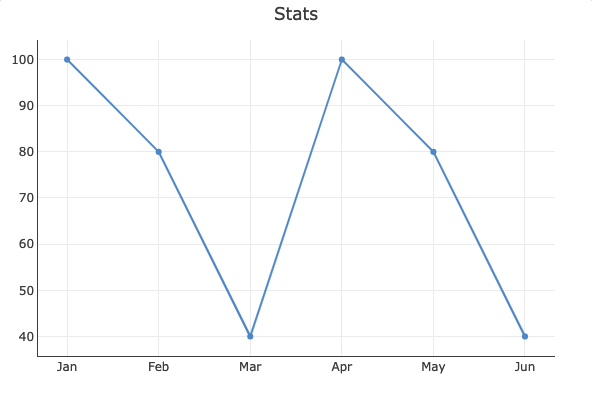
Bar charts
Data requirements: The data needs to be an array of objects and each object should have x and y keys.
Example:
[
{ "x": "Jan", "y": 100},
{ "x": "Feb", "y": 80},
{ "x": "Mar", "y": 40},
{ "x": "Apr", "y": 100},
{ "x": "May", "y": 80},
{ "x": "Jun", "y": 40},
{ "x": "Jul", "y": 100},
{ "x": "Aug", "y": 80},
{ "x": "Sep", "y": 40}
]
The chart will look like this:

Pie charts
Data requirements: The data needs to be an array of objects and each object should have label and value keys.
Example:
[
{ "x": "Jan", "y": 100},
{ "x": "Feb", "y": 80},
{ "x": "Mar", "y": 40},
{ "x": "Apr", "y": 100},
{ "x": "May", "y": 80},
{ "x": "Jun", "y": 40}
]
The chart will look like this:
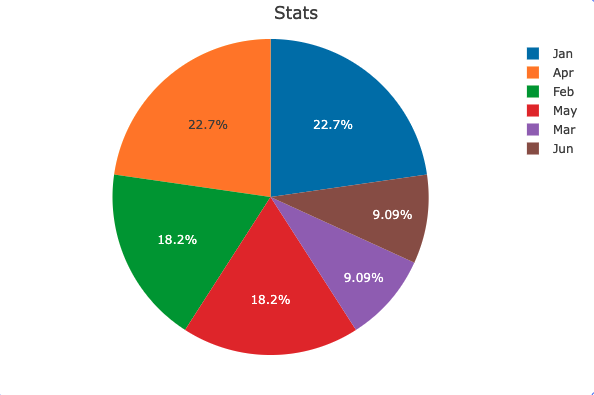
Properties
Any property having Fx button next to its field can be programmatically configured.
Title
This field is used to add a title to your selected chart.
Plotly JSON Chart Schema
You have the option to plot a chart using JSON data in the chart component. This JSON data contains information about the chart type, chart data, and more. You can find details about the JSON properties here.
To work with the JSON data, you need to enable the Plotly JSON chart schema toggle in the properties section. Once enabled, you can provide the JSON data in the JSON description field.
The resulting chart will be generated based on the provided JSON data, allowing you to customize the chart's appearance and functionality.
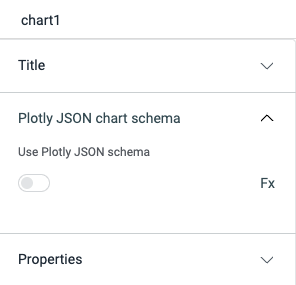
You can refer to the JSON Chart Schema for more information on constructing the JSON data structure.
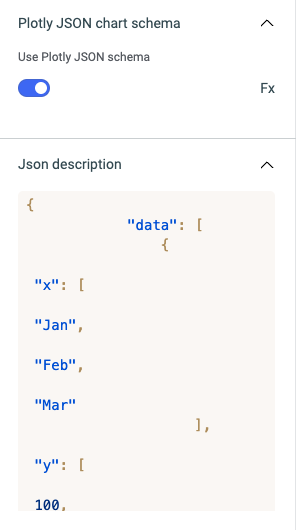
Bar Mode
The Bar Mode option allows you to customize the layout and display style specifically for bar charts. This option becomes available when the Plotly JSON chart schema toggle is enabled and a JSON schema specific to bar charts is provided. This option provide different modes for organizing and presenting bars within the chart.
Please note that the Bar Mode option only affects the layout of bar charts, and it requires a JSON schema specifically designed for bar charts. It cannot be used to modify the layout of other chart types such as line charts or pie charts.
It offers four different modes:
1. Stack Mode: Bars are stacked on top of each other, displaying the total value of each category as well as the individual values within the stack.
2. Group Mode: Bars of different categories are grouped together side by side, facilitating direct comparison between the groups and their subcategories.
3. Overlay Mode: Bars from different categories overlap with slight offsets, allowing for detailed visual comparison of individual values across categories.
4. Relative Mode: Bars represent proportions or percentages relative to a reference value, emphasizing the relative significance of each category.
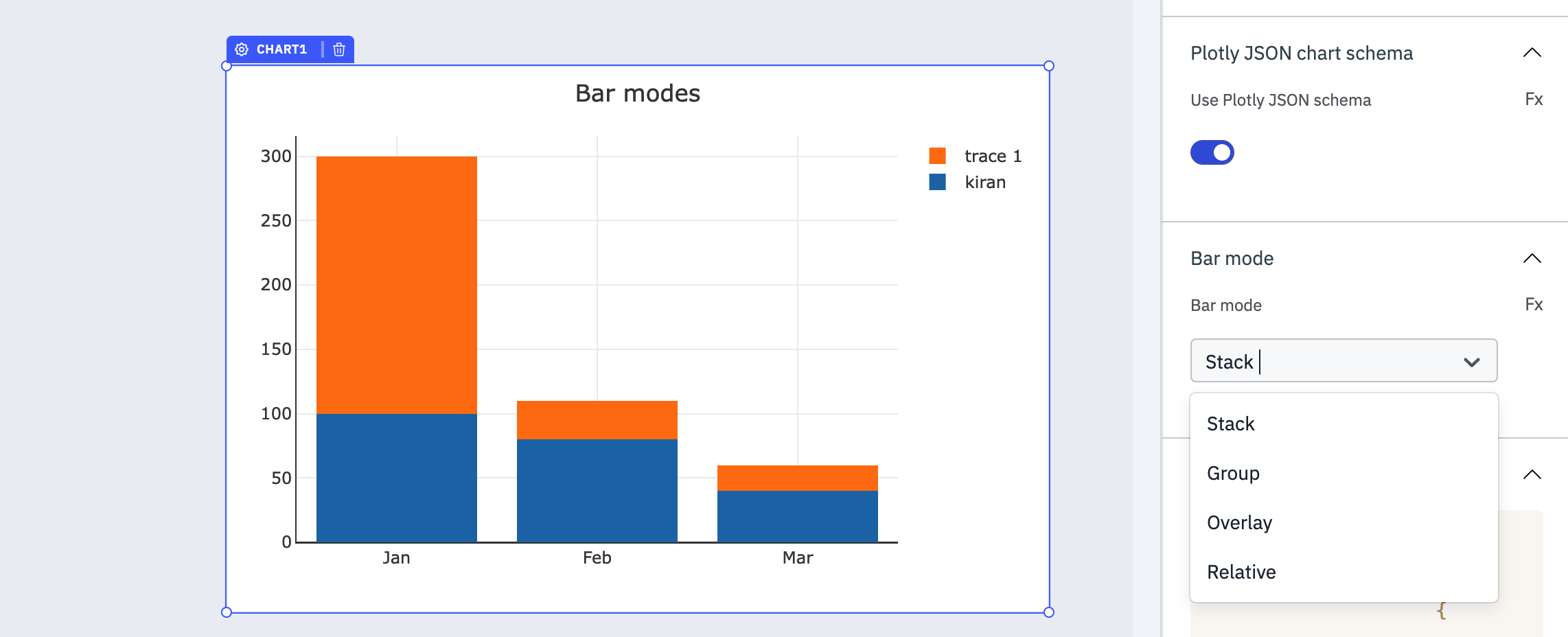
Using Plotly JSON chart schema
In the JSON description, the value needs to be the data array with x and y axis values and at the end we need to specify the type. let's take a look at the examples for different chart types.
Line
{
"data": [
{
"x": [
"Jan",
"Feb",
"Mar"
],
"y": [
100,
80,
40
],
"type": "line"
},
{
"x": [
"Jan",
"Feb",
"Mar"
],
"y": [
300,
30,
20
],
"type": "line"
}
]
}

Bar
{
"data": [
{
"name": "SF Zoo",
"type": "bar",
"x": [
20,
14,
23
],
"y": [
"giraffes",
"orangutans",
"monkeys"
],
"marker": {
"line": {
"color": "rgba(55, 128, 191, 1.0)",
"width": 1
},
"color": "rgba(55, 128, 191, 0.6)"
},
"orientation": "h"
},
{
"name": "LA Zoo",
"type": "bar",
"x": [
12,
18,
29
],
"y": [
"giraffes",
"orangutans",
"monkeys"
],
"marker": {
"line": {
"color": "rgba(255, 153, 51, 1.0)",
"width": 1
},
"color": "rgba(255, 153, 51, 0.6)"
},
"orientation": "h"
}
],
"layout": {
"barmode": "stack"
},
"frames": []
}

Area
{
"data": [
{
"uid": "babced",
"fill": "tonexty",
"mode": "none",
"name": "Col2",
"type": "scatter",
"x": [
"2000-01-01",
"2001-01-01",
"2002-01-01",
"2003-01-01",
"2004-01-01",
"2005-01-01",
"2006-01-01",
"2007-01-01",
"2008-01-01",
"2009-01-01",
"2010-01-01",
"2011-01-01",
"2012-01-01",
"2013-01-01",
"2014-01-01",
"2015-01-01",
"2016-01-01"
],
"y": [
"17087182",
"29354370",
"38760373",
"40912332",
"51611646",
"64780617",
"85507314",
"121892559",
"172338726",
"238027855",
"206956723",
"346004403",
"697089489",
"672985183",
"968882453",
"863105652",
"1068513050"
],
"fillcolor": "rgb(224, 102, 102)"
}
],
"layout": {
"title": "Total Number of Websites",
"width": 800,
"xaxis": {
"type": "date",
"range": [
946702800000,
1451624400000
],
"title": "Source: <a href=\"http://www.scribblrs.com/\">Scribblrs</a><br>Source: <a href=\"http://www.internetlivestats.com/total-number-of-websites/\">Internet Live Stats</a>",
"showgrid": false,
"autorange": true,
"tickformat": "%Y"
},
"yaxis": {
"type": "linear",
"range": [
0,
1124750578.9473684
],
"title": "",
"autorange": true
},
"height": 500,
"autosize": false
},
"frames": []
}

Few more exmaples:
Link to JSON description: https://raw.githubusercontent.com/plotly/plotly.js/master/test/image/mocks/0.json

Link to JSON description: https://raw.githubusercontent.com/plotly/plotly.js/master/test/image/mocks/12.json

Check the Plotly documentation to explore the all type of charts available.
Marker color
Modify the color of marker using the color picker or by providing a HEX color code.
Options
Loading state
Toggle on the switch to display a loader on the widget. You can also programmatically define it's value by clicking on Fx, acceptable values are - {{true}} and {{false}}.
Show Axes
Enable or disable the x and y axes on the chart through this property. You can also programmatically define it's value by clicking on Fx, acceptable values are - {{true}} and {{false}}.
Show grid lines
Toggle on or off to show or hide the grid lines on the chart. You can also programmatically define it's value by clicking on Fx, acceptable values are - {{true}} and {{false}}.
Layout

Show on desktop
Toggle on or off to display the widget in desktop view. You can programmatically determine the value by clicking on Fx to set the value {{true}} or {{false}}.
Show on mobile
Toggle on or off to display the widget in mobile view. You can programmatically determine the value by clicking on Fx to set the value {{true}} or {{false}}.
Styles

Padding
Define a space between the widget element and the widget border using Padding property. Use any numerical value between 1 to 100.
Visibility
Toggle on or off to control the visibility of the widget. You can programmatically change its value by clicking on the Fx button next to it. If {{false}} the widget will not be visible after the app is deployed. By default, it's set to {{true}}.
Disable
This is off by default, toggle on the switch to lock the widget and make it non-functional. You can also programmatically set the value by clicking on the Fx button next to it. If set to {{true}}, the widget will be locked and becomes non-functional. By default, its value is set to {{false}}.
Exposed variables
There are currently no exposed variables for the component.
Component specific actions (CSA)
There are currently no CSA (Component-Specific Actions) implemented to regulate or control the component.